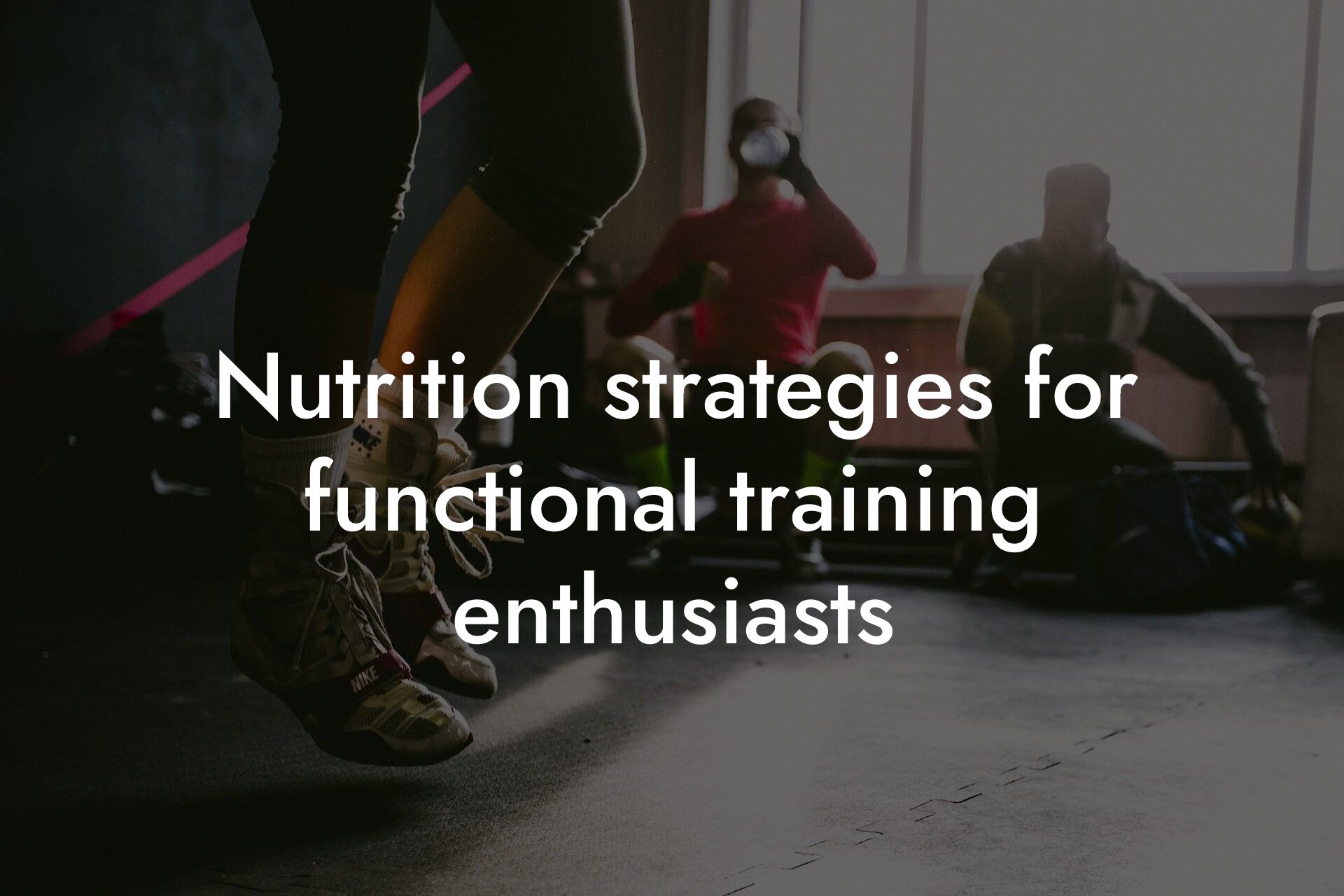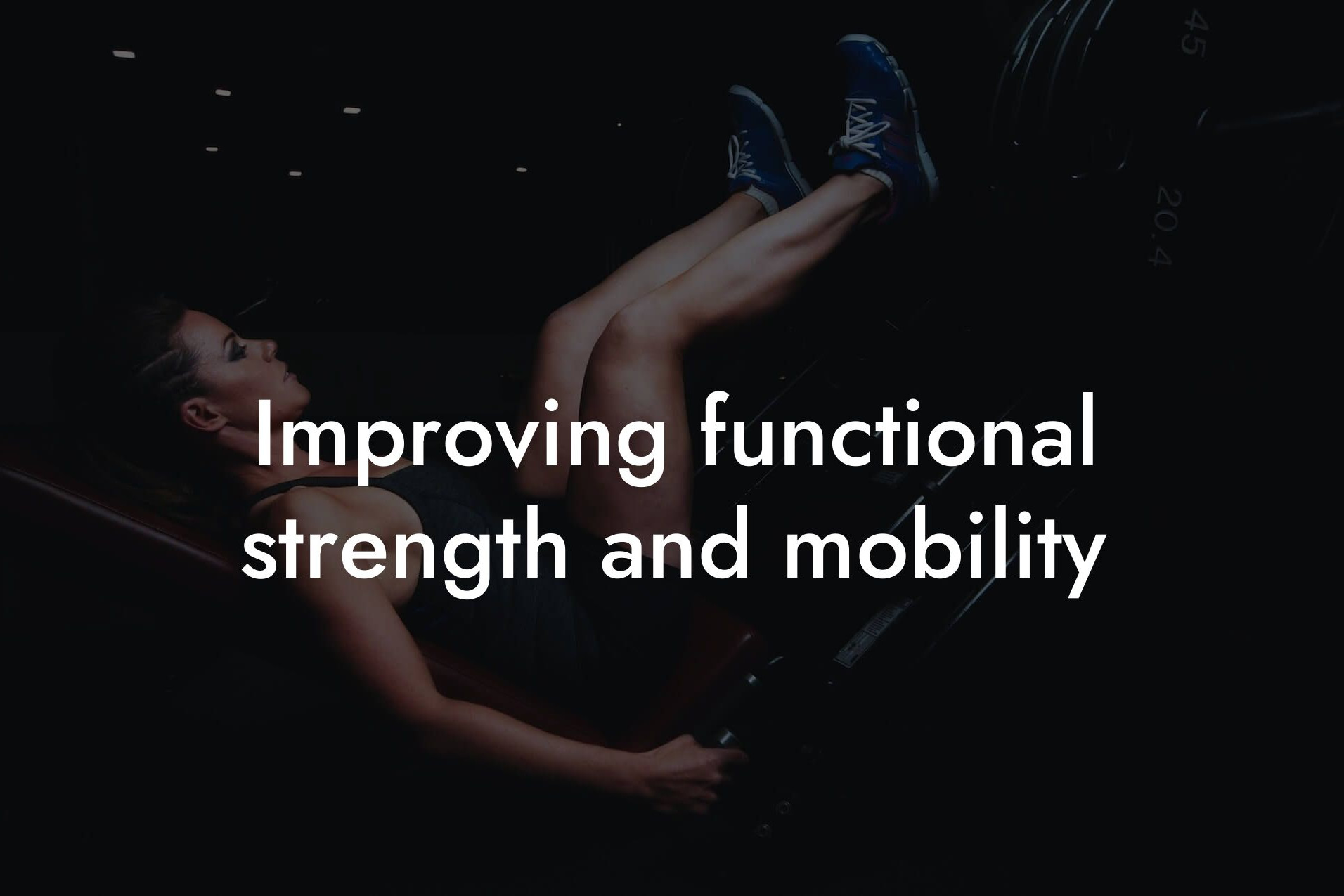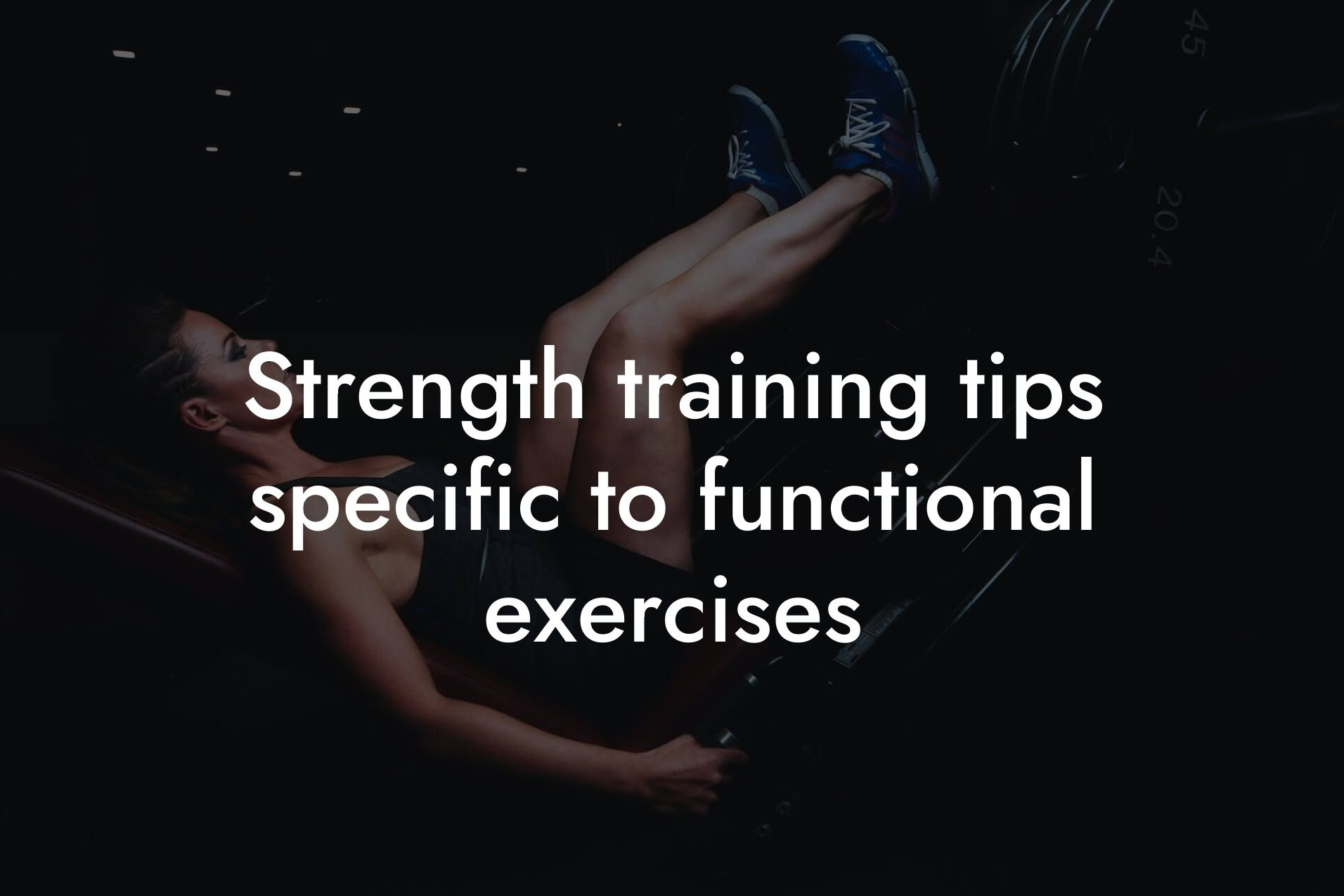As a high-earning professional, you understand the importance of maintaining a healthy and fit physique. Functional training has become a popular way to improve overall fitness and athleticism, but it's not without its risks. Injuries can occur when proper precautions are not taken, and they can set you back significantly, affecting not only your physical appearance but also your business performance. At Tano Performance Group, we want to ensure that you have all the information you need to prevent injuries and get the most out of your functional training.
Table of Contents
- Common Injuries in Functional Training
- Warm-Up and Cool-Down: The Importance of Proper Preparation
- Proper Form and Technique: The Key to Injury Prevention
- Listen to Your Body: The Importance of Rest and Recovery
- Strengthening Your Core and Glutes: The Foundation of Functional Training
- Incorporating Injury Prevention Exercises into Your Routine
- Monitoring Your Progress: The Importance of Body Assessment
- Frequently Asked Questions
Common Injuries in Functional Training
Before we dive into prevention strategies, it's essential to understand the types of injuries that can occur in functional training. Some of the most common injuries include:
- Muscle strains and pulls: Overexertion or poor form can lead to muscle strains and pulls, particularly in the legs, back, and shoulders.
- Joint injuries: The high-impact nature of functional training can put excessive stress on joints, leading to injuries such as tendonitis, ligament sprains, and meniscal tears.
- Overuse injuries: Repetitive movements and high-intensity exercises can cause overuse injuries, such as shin splints, stress fractures, and IT band syndrome.
- Concussions and head injuries: Contact exercises and high-impact movements can increase the risk of concussions and head injuries.
Warm-Up and Cool-Down: The Importance of Proper Preparation
A proper warm-up and cool-down are crucial in preventing injuries in functional training. A warm-up prepares your muscles for exercise, increases blood flow, and reduces the risk of muscle strains. A cool-down, on the other hand, helps to reduce muscle soreness, improve recovery, and prevent injuries.
A good warm-up should include light cardio, dynamic stretching, and mobility exercises. This can include jogging, jumping jacks, leg swings, arm circles, and hip openers. Aim for a 10-15 minute warm-up to get your body ready for exercise.
A cool-down should focus on static stretching, foam rolling, and self-myofascial release. This can include exercises such as hamstring and quadriceps stretches, chest opens, and hip flexor releases. Aim for a 10-15 minute cool-down to help your body recover.
Proper Form and Technique: The Key to Injury Prevention
Proper form and technique are essential in preventing injuries in functional training. When you use proper form, you reduce the risk of overexertion, muscle imbalances, and joint stress. Here are some tips to ensure proper form and technique:
- Start with lighter weights and progress gradually: This allows you to develop strength and control without putting excessive stress on your muscles and joints.
- Focus on slow and controlled movements: Avoid jerky or bouncy movements, which can put excessive stress on your muscles and joints.
- Engage your core: Your core muscles, including your abs and lower back, play a crucial role in maintaining proper form and technique.
- Keep your joints in alignment: Make sure your joints are in alignment with the movement, avoiding excessive stress and strain.
Listen to Your Body: The Importance of Rest and Recovery
Rest and recovery are critical components of injury prevention in functional training. When you ignore your body's warning signs, you increase the risk of injury. Here are some tips to ensure you're listening to your body:
- Take rest days: Aim for at least one or two rest days per week, depending on your training intensity and frequency.
- Pay attention to pain: If you experience pain or discomfort, stop the exercise immediately and rest.
- Focus on active recovery: Engage in low-intensity activities such as yoga, stretching, or light cardio to aid in recovery.
- Get enough sleep: Aim for 7-9 hours of sleep per night to aid in recovery and muscle repair.
Strengthening Your Core and Glutes: The Foundation of Functional Training
Strengthening your core and glutes is essential in preventing injuries in functional training. These muscles play a crucial role in maintaining proper form and technique, and they help to reduce the risk of overexertion and muscle imbalances. Here are some exercises to strengthen your core and glutes:
- Planks: Hold a plank position for 30-60 seconds, rest for 30 seconds, and repeat for 3-5 sets.
- Deadlifts: Perform deadlifts with proper form, focusing on engaging your glutes and core muscles.
- Squats: Perform squats with proper form, focusing on engaging your glutes and core muscles.
- Lunges: Perform lunges with proper form, focusing on engaging your glutes and core muscles.
Incorporating Injury Prevention Exercises into Your Routine
Incorporating injury prevention exercises into your routine can help to reduce the risk of injury. Here are some exercises to consider:
- Glute bridges: Perform glute bridges to strengthen your glutes and improve hip mobility.
- Lateral band walks: Perform lateral band walks to strengthen your glutes and improve hip stability.
- Single-leg squats: Perform single-leg squats to improve balance, strength, and stability.
- Calf raises: Perform calf raises to strengthen your calf muscles and improve ankle stability.
Monitoring Your Progress: The Importance of Body Assessment
Monitoring your progress is crucial in preventing injuries in functional training. At Tano Performance Group, we use DEXA machines to provide a complete body assessment, including body fat percentage, bone density, and muscle mass. This information helps you to identify areas of improvement, track your progress, and make data-driven decisions about your training.
A regular body assessment can help you to:
- Identify muscle imbalances and weaknesses
- Track changes in body composition
- Monitor progress and adjust your training program
- Reduce the risk of injury and improve overall performance
Injury prevention is a critical component of functional training. By understanding the risks, warming up and cooling down properly, using proper form and technique, listening to your body, strengthening your core and glutes, incorporating injury prevention exercises, and monitoring your progress, you can reduce the risk of injury and achieve your fitness goals. At Tano Performance Group, we're committed to helping you achieve optimal physical performance and take your business to the next level. Contact us today to learn more about our DEXA machine and body assessment services.
Frequently Asked Questions
What is functional training, and how does it differ from traditional weightlifting?
Functional training is a type of exercise that focuses on improving coordination, balance, and overall functional movement patterns. It differs from traditional weightlifting in that it often incorporates multi-planar movements, rotational forces, and dynamic movements that mimic real-life activities. This approach helps improve functional strength, mobility, and overall athleticism, making it an excellent choice for individuals looking to enhance their physical performance and reduce the risk of injury.
Why is injury prevention crucial in functional training?
Injury prevention is vital in functional training because it allows individuals to maintain consistency in their training, avoid setbacks, and achieve their fitness goals. Functional training often involves complex movements that can be stressful on the joints and muscles, making it essential to take proactive measures to prevent injuries. By incorporating injury prevention strategies into your training, you can reduce the risk of injury, optimize your performance, and enjoy long-term success.
What are the most common injuries that occur in functional training?
The most common injuries that occur in functional training include lower back strains, shoulder impingements, knee injuries, and ankle sprains. These injuries often result from poor form, inadequate warm-ups, and insufficient cool-downs. Additionally, overtraining, poor nutrition, and inadequate recovery can also contribute to the risk of injury.
How can I warm up properly before functional training?
A proper warm-up is essential before functional training. It should include a combination of cardio, mobility, and dynamic movements that prepare your muscles for the upcoming exercise. A good warm-up should last around 10-15 minutes and include exercises such as light cardio, leg swings, arm circles, and hip openers. This will help increase blood flow, reduce muscle stiffness, and prepare your joints for movement.
What are some common mistakes that people make in functional training that can lead to injury?
Some common mistakes that people make in functional training that can lead to injury include poor form, inadequate warm-ups, and insufficient cool-downs. Additionally, overtraining, poor nutrition, and inadequate recovery can also contribute to the risk of injury. It's essential to focus on proper form, listen to your body, and prioritize recovery to minimize the risk of injury.
How can I improve my form and technique in functional training?
Improving your form and technique in functional training requires practice, patience, and attention to detail. Start by breaking down complex movements into smaller parts, focus on proper body positioning, and engage your core muscles. It's also essential to work with a qualified trainer or coach who can provide personalized feedback and guidance.
What is the importance of core strength in functional training?
Core strength is essential in functional training because it provides a solid foundation for movement. A strong core helps improve stability, balance, and overall functional movement patterns. It also reduces the risk of injury by providing additional support to the joints and muscles. Incorporating exercises that target the core muscles, such as planks, Russian twists, and leg raises, can help improve overall core strength and stability.
How can I incorporate functional training into my busy schedule?
Incorporating functional training into your busy schedule requires creativity and flexibility. Start by identifying your goals and priorities, and then create a training schedule that works for you. Consider working with a trainer or coach who can provide personalized guidance and support. Additionally, focus on exercises that can be done in a short amount of time, such as high-intensity interval training (HIIT) or bodyweight exercises.
What are some effective exercises for improving functional strength?
Some effective exercises for improving functional strength include squats, lunges, deadlifts, bench press, and rows. These exercises target multiple muscle groups, improve overall strength, and enhance functional movement patterns. Additionally, incorporating exercises that mimic real-life activities, such as carrying heavy objects or performing rotational movements, can also help improve functional strength.
How can I prevent lower back injuries in functional training?
Preventing lower back injuries in functional training requires a combination of proper form, core strength, and flexibility. Focus on engaging your core muscles, maintaining a neutral spine, and avoiding heavy loads or excessive twisting. Additionally, incorporating exercises that target the lower back muscles, such as lat pulldowns and bird dogs, can help improve strength and stability.
What is the importance of flexibility and mobility in functional training?
Flexibility and mobility are essential in functional training because they allow for optimal range of motion and reduce the risk of injury. Incorporating exercises that target flexibility and mobility, such as yoga or dynamic stretching, can help improve overall functional movement patterns and reduce muscle stiffness.
How can I incorporate stretching and foam rolling into my functional training routine?
Incorporating stretching and foam rolling into your functional training routine can help improve flexibility, reduce muscle soreness, and enhance recovery. Focus on stretching major muscle groups, such as the hamstrings, quadriceps, and chest, and use foam rolling to target areas of tension and tightness.
What are some common mistakes that people make when it comes to stretching and foam rolling?
Some common mistakes that people make when it comes to stretching and foam rolling include not holding stretches for long enough, using too much force, and neglecting to stretch major muscle groups. Additionally, not incorporating stretching and foam rolling into their routine regularly can also lead to reduced flexibility and increased muscle soreness.
How can I prevent shoulder injuries in functional training?
Preventing shoulder injuries in functional training requires a combination of proper form, shoulder stability, and flexibility. Focus on engaging your shoulder muscles, maintaining proper posture, and avoiding heavy loads or excessive rotation. Additionally, incorporating exercises that target the shoulder muscles, such as shoulder press and lateral raises, can help improve strength and stability.
What are some effective exercises for improving shoulder stability?
Some effective exercises for improving shoulder stability include shoulder press, lateral raises, and reverse flys. These exercises target the shoulder muscles, improve overall strength, and enhance functional movement patterns. Additionally, incorporating exercises that mimic real-life activities, such as carrying heavy objects or performing rotational movements, can also help improve shoulder stability.
How can I prevent knee injuries in functional training?
Preventing knee injuries in functional training requires a combination of proper form, knee stability, and flexibility. Focus on engaging your knee muscles, maintaining proper alignment, and avoiding heavy loads or excessive impact. Additionally, incorporating exercises that target the knee muscles, such as squats and lunges, can help improve strength and stability.
What are some effective exercises for improving knee stability?
Some effective exercises for improving knee stability include squats, lunges, and leg press. These exercises target the knee muscles, improve overall strength, and enhance functional movement patterns. Additionally, incorporating exercises that mimic real-life activities, such as jumping or cutting, can also help improve knee stability.
How can I prevent ankle injuries in functional training?
Preventing ankle injuries in functional training requires a combination of proper form, ankle stability, and flexibility. Focus on engaging your ankle muscles, maintaining proper alignment, and avoiding heavy loads or excessive rotation. Additionally, incorporating exercises that target the ankle muscles, such as calf raises and ankle circles, can help improve strength and stability.
What are some effective exercises for improving ankle stability?
Some effective exercises for improving ankle stability include calf raises, ankle circles, and single-leg squats. These exercises target the ankle muscles, improve overall strength, and enhance functional movement patterns. Additionally, incorporating exercises that mimic real-life activities, such as jumping or cutting, can also help improve ankle stability.
How can I incorporate functional training into my fitness routine if I'm a beginner?
Incorporating functional training into your fitness routine as a beginner requires starting slowly and progressing gradually. Start with simple exercises and movements, and gradually increase the intensity and complexity as you become more comfortable. It's also essential to work with a qualified trainer or coach who can provide personalized guidance and support.
What are some common misconceptions about functional training?
Some common misconceptions about functional training include the idea that it's only for athletes or that it's too intense for beginners. However, functional training can be adapted to suit any fitness level, and it's an excellent way to improve overall physical performance and reduce the risk of injury.
How can I measure my progress in functional training?
Measuring progress in functional training requires tracking a combination of metrics, including strength, speed, agility, and overall functional movement patterns. Use tools such as fitness trackers, heart rate monitors, and performance metrics to track your progress and adjust your training accordingly.
Here are some related articles you might love...
- Nutrition strategies for functional training enthusiasts
- Improving functional strength and mobility
- Strength training tips specific to functional exercises
- The importance of bone density in functional fitness
- Balancing strength, speed, and flexibility in functional training
- Maintaining muscle recovery with functional training
- How DEXA scans can benefit functional training athletes
- The role of body composition in functional training performance
- Reducing body fat for better functional training results
Zak Faulkner
Zak Faulkner is a leading authority in the realm of physical health and body composition analysis, with over 15 years of experience helping professionals optimise their fitness and well-being. As one the experts behind Tano Performance Group, Zak has dedicated his career to providing in-depth, science-backed insights that empower clients to elevate their physical performance and overall health.
With extensive knowledge of DEXA technology, Zak specializes in delivering comprehensive body assessments that offer precise data on body fat, muscle mass, bone density, and overall physique. His expertise enables individuals to make informed decisions and achieve their fitness goals with accuracy and confidence. Zak’s approach is rooted in a deep understanding of human physiology, combined with a passion for helping clients unlock their full potential through personalised strategies.
Over the years, Zak has earned a reputation for his commitment to excellence, precision, and client-focused service. His guidance is trusted by top professionals who demand the best when it comes to their health. Whether advising on fitness programs, nutritional strategies, or long-term wellness plans, Zak Faulkner’s insights are a valuable resource for anyone serious about taking their health and fitness to the next level.
At Tano Performance Group, Zak continues to lead our Content Team revolutionising how professionals approach their physical health, offering unparalleled expertise that drives real results.




